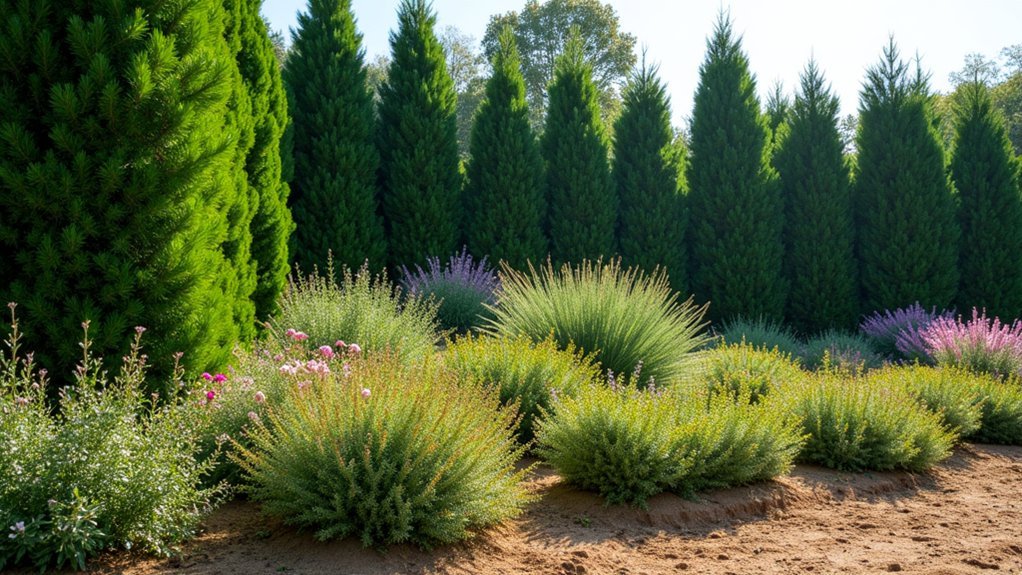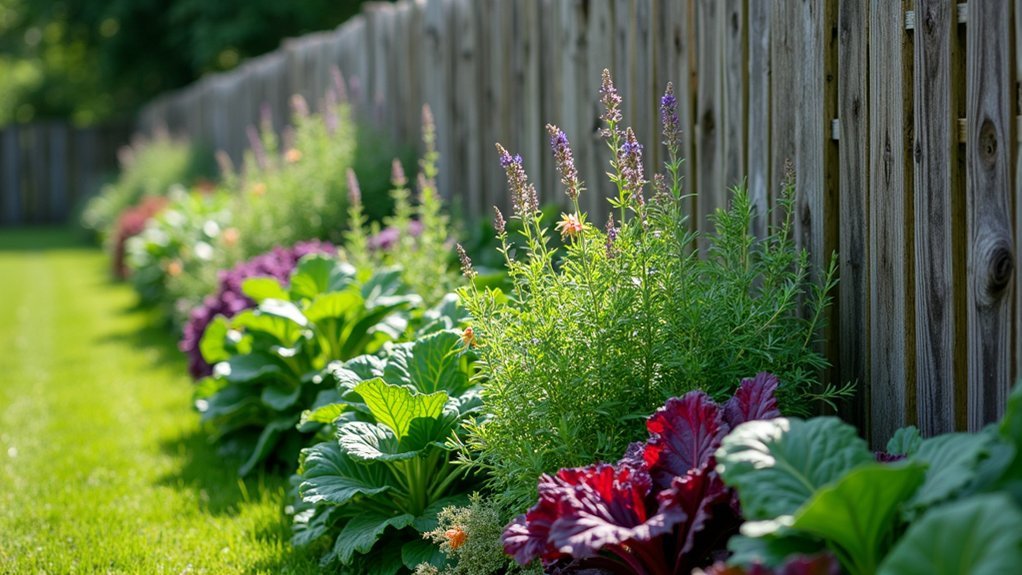Effective windbreaks should be 1.5 to 2 times taller than the plants or structures you’re protecting. For ideal protection, aim for windbreaks at least 1.5-2 meters high, as shorter barriers (under 1 meter) provide minimal benefit. Taller windbreaks create larger protection zones, sheltering areas up to 10 times their height. You’ll need to balance height with potential shading effects on sun-loving crops. The right height strategy will dramatically improve your garden’s microclimate.
Factors That Determine Optimal Windbreak Height

When designing an effective windbreak, height stands as the most vital factor determining its success. Your windbreak height directly influences the area protected, with shelter zones typically extending up to 10 times the height of your tallest trees on the leeward side.
You’ll need to take into account prevailing wind direction and wind speed in your location, as height should be matched to local conditions. While 1-meter tall barriers offer minimal protection, aim for at least 1.5-2 meters to prevent wind barreling underneath.
The number of rows and species of trees you select greatly impact mature height potential and overall effectiveness.
Your windbreak’s strength lies in diversity—carefully chosen species and multiple rows maximize height potential and protection.
Proper windbreak planning involves analyzing your specific needs—taller windbreaks create larger shelter zones for crops and livestock, making dominant tree height a vital consideration in your design.
Height Guidelines for Different Protection Zones
Because your windbreak’s effectiveness depends directly on its height-to-protection ratio, understanding specific height guidelines for different zones is essential.
For maximum protection, your windbreak should stand at least 1.5 to 2 times taller than the plants you’re protecting.
Height dramatically affects the protected area’s reach—a well-designed windbreak can shield areas extending up to 10 times its height on the leeward side.
For example, a 10-foot windbreak protects up to 100 feet away from the windward side, while a 20-foot barrier extends coverage to 200 feet.
When planning your design, verify your trees and shrubs exceed 1 meter in total height—anything below 0.46 meters won’t effectively redirect wind.
Instead, air will simply barrel over shorter windbreaks, leaving your protected area vulnerable.
Impact of Plant Height on Wind Speed Reduction

While designing your windbreak, plant height serves as the primary factor determining how effectively you’ll reduce wind speeds across your property. Taller trees create larger protected areas, with wind reductions measurable up to 5 times the windbreak height on the windward side and an impressive 30 times on the leeward side.
For example, a 20-foot windbreak can shield areas up to 200 feet away. You’ll want your windbreak to exceed surrounding structures’ height for maximum protection.
For ideal wind speed reduction, verify your windbreak reaches at least 1 meter high—anything shorter may cause wind to barrel through rather than over the barrier.
When selecting plant species, prioritize those that will grow tall enough to serve your specific protection needs, combining trees and shrubs for thorough coverage.
Balancing Height With Sunlight Accessibility
Finding the sweet spot between effective wind protection and adequate sunlight exposure presents a critical challenge in windbreak design. Your windbreak depends on exceeding 1 meter in height to provide meaningful protection, but this must be balanced against the need for sunlight accessibility across your growing area.
Remember that ideal wind protection requires a windbreak roughly 10 times the height of the tallest plants in your plot.
However, excessive height may create unwanted shade that promotes disease problems in sun-loving crops. Consider incorporating low-growing shrubs strategically where full protection isn’t necessary.
Seasonal Growth Considerations for Windbreak Maintenance

As windbreak plants progress through seasonal growth cycles, you’ll need to adapt your maintenance strategy accordingly. Monitor growth rates during spring when most windbreak plants experience rapid development, ensuring they maintain protection reaching 5-10 times the height of structures they shield.
Adapt maintenance as your windbreaks grow, paying special attention during spring’s growth surge to maintain optimal protective reach.
Seasonal growth patterns vary considerably among tree species, with some requiring pruning during dormant months to prevent excessive height that could overshadow your plot.
Establish multiple rows of trees for year-round protection, accounting for density fluctuations throughout seasons. Your local climate conditions will dictate maintenance timing—fertilize and irrigate during growing seasons to support ideal development.
Remember that windbreak plants in harsh climates may require additional attention to reach their perfect protective height, particularly if they face stress during extreme weather events.
Frequently Asked Questions
How High Should a Windbreak Be?
You’ll want a windbreak at least 3.3 feet high, but taller is better. Your windbreak can protect areas up to 10 times its height—a 20-foot barrier shields 200 feet downwind.
How Tall Should a Windbreak Wall Be?
Your windbreak wall should be at least 1.5-2 times taller than what you’re protecting. For effective protection, aim for a minimum height of 1 meter, with taller barriers providing protection up to 10 times their height downwind.
What Is the Effect of the Height of a Windbreak?
The height of a windbreak determines your protected area. You’ll get protection for about 10 times the tallest tree’s height on the leeward side, with taller barriers creating larger sheltered zones and reducing wind speed effectively.
Where Should Windbreaks Be Placed?
Place your windbreaks perpendicular to prevailing winds, extending at least 100 feet beyond the protected area. They’ll work best when they’re 10 times longer than their height, with angled access points to minimize gaps.
In Summary
When planning your windbreak, you’ll need to match plant heights to your specific protection needs. For homes, aim for windbreaks 1-2 times the height of structures you’re protecting. Remember, taller isn’t always better—you’ll want to balance wind reduction with sunlight access. Choose species that maintain their protective height year-round, and you’ll create an effective shield that works through all seasons.





Leave a Reply